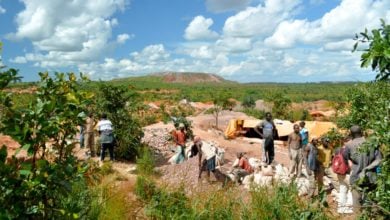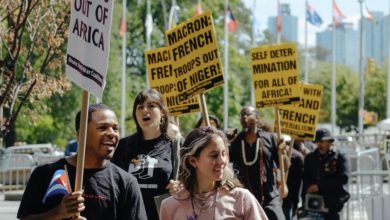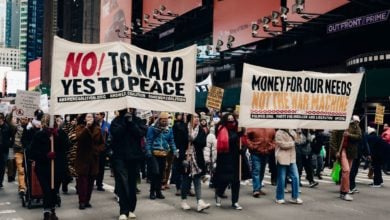South Africa reverberated with the echoes of freedom songs on June 13 when one million workers shut down cities across the country, including Durbin and Johannesburg’s city center. The day of action resembled something close to a general strike. The strike is the largest labor action in South Africa in the post-apartheid era.
The massive demonstrations were organized by the Congress of South African Trade Unions to support the striking
|
Nearly one million hospital and education workers have been on strike since June 1 to protest the paltry raise offer from the ruling African National Congress government. Workers demanded a 12 percent wage increase, but were only offered 6 percent. This year alone, inflation rose by seven percent.
The strikers have now revised their original demand for the 12 percent wage increase to 10 percent. On June 21, COSATU rejected the government’s latest 7.5 percent increase offer. COSATU has declared this a “must win” strike.
The federal government’s offer is tiny in comparison to what top government leaders may get. A government commission on wages recently suggested 57 percent wage increases for President Thabo Mbeki and his cabinet. One striker told Reuters, “They live in luxury, we still stay in poverty.”
The public sector strike has become a major issue in South Africa, occurring at a time when the economic and political direction of the post-apartheid era is being critically evaluated. Broad masses of workers are looking for a different way forward.
Neoliberal development
After leading the victory against the forces of racist apartheid, the African National Congress and its allies assumed political power in South Africa in 1994. They had successfully dismantled the apartheid system, but the social system remained unchanged. The South African Communist Party calls the political transformation a “National Democratic Revolution.”
The ANC’s 1955 Freedom Charter—a document that gave ideological direction to the anti-apartheid struggle—pledged support for thoroughgoing social democratic reforms, including the nationalization of major industries and banks.
But in the post-apartheid period, leaders affiliated with the ANC gravitated toward development on a purely capitalist basis. The moves were supported initially, with some reservations, by its electoral allies in the SACP and COSATU.
The ANC is the broadest of the three organizations, known as the Tripartite Alliance. The ANC has members from all classes, including members and aspiring members of the bourgeoisie. COSATU, as a union federation, is dedicated to advancing workers’ economic interests.
The SACP’s official political program proclaims that it is dedicated to socialism, although in its current strategic orientation it is not currently aiming at a socialist overturn of the existing social order. Rather, it identifies its role now as a partner in a “multi-class project.” Its working-class base is unable to be content, however, with the neo-liberal policies of the South African government.
This situation has generated political contradictions that reflect the multi-class character of the political leadership of the ANC. The ANC government has been committed to a neoliberal economic program favored by the International Monetary Fund. Basic utilities have been privatized.
South Africa’s neoliberal path was solidified with the implementation of the Growth Employment and Redistribution plan in 1996.
GEAR destroyed much of the country’s social spending from 1996-2000—its official time of existence. Part of GEAR was the adoption of IMF/World Bank-style schemes. These strengthened South Africa’s economy from the standpoint of the western imperialists.
But the masses of Black South Africans remained overwhelmingly poor and exploited, continuing to live in ghetto and slum conditions. Limited access to clean water and electricity exacerbated the problem, as did the government’s lack of action in combating the HIV/AIDS crisis.
While this was happening, some former ANC leaders and supporters became affluent as business people. But the economy remained, as it does today, largely in the hands of the former white ruling class.
Sharpening social conflict
The SACP and COSATU began to criticize sharply government policies and their resulting inequities. In response, the government increased social spending in its 2002 budget.
Many workers, however, saw the SACP’s and COSATU’s challenges as not going far enough. Dissatisfaction among the ranks of workers, including many former anti-apartheid activists, led to the formation of new local and regional organizations. These groups were formed to protest openly the injustices of poverty ravaging their country.
Protest movements in post-apartheid South Africa have grown. Sometimes the government has used repression to subdue the protests. These actions too have caused the SACP and some elements of COSATU to examine their relationship to the South African state.
The rank and file of both the SACP and COSATU has forced their leaders to take a strong position on the ANC’s current policies, both economic and otherwise. Some want to break completely with the ANC; others want to distance themselves from the ANC’s policies and attempt to win it over during the 2009 presidential nominating process.
It is not clear what will happen in South Africa in the short term. The public sector strike is an indicator of the growing power and frustration of the Black working class.
At this stage, a decisive move away from neoliberalism would be a victory for the South African workers. But true equality—social equality—for Black South Africans cannot take place within the bounds of capitalism.
That is the main challenge facing revolutionaries in South Africa. It is the reason that communism remains alive in the fields and mines and on the streets of South Africa today.







